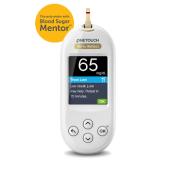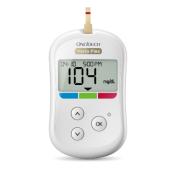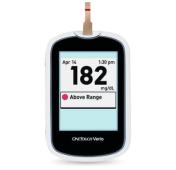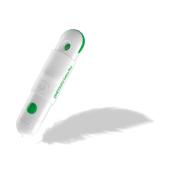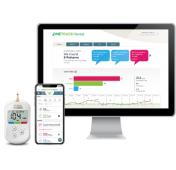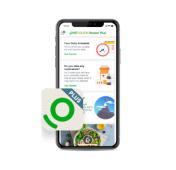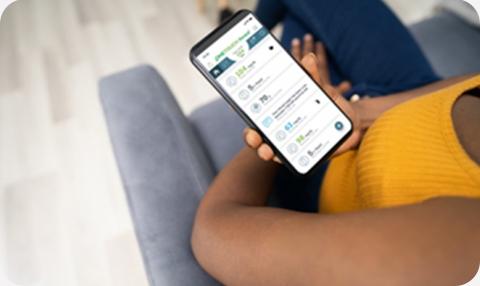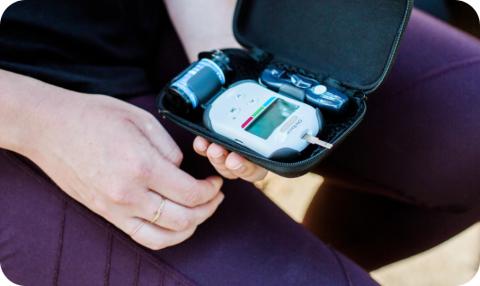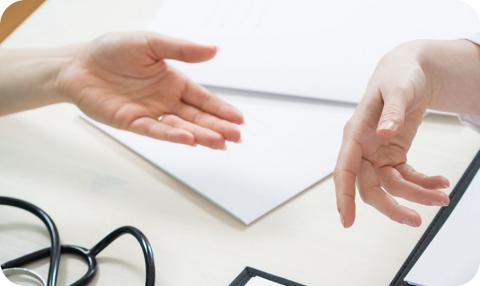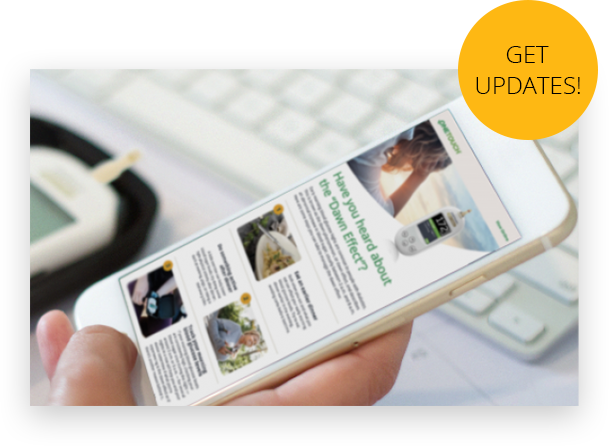What is Continuous Glucose Monitoring?

By: Diana Isaacs, PharmD, BCPS, BC-ADM, CDCES, FADCES
Introducing CGM1,2
A Continuous Glucose Monitoring system, also called CGM, is a way to measure blood sugar for people with diabetes. It is a device that is typically worn on the back of the upper arm or stomach, and depending on the specific type, can check blood sugar levels every one to five minutes. If you do the math, this is 288 to 1440 readings per day! For the person using their glucose meter as recommended by their healthcare professional, CGM can provide much more data than traditional blood glucose meters.
In addition to more data, there are other differences between CGM and blood glucose meters (BGM). A reading taken by a finger stick using a glucose meter shows your blood sugar level at that moment in time, while CGM shows you the number AND the direction that your blood sugar is going. Imagine having a blood sugar of 100 mg/dL and thinking everything is fine because you are in target range, but not realizing that your blood sugar is dropping. This could become a dangerous situation especially if you don’t feel the usual symptoms of low blood sugar. CGM will display arrows to indicate if blood sugar is dropping and can even show the rate at which it is decreasing. For example, some CGM devices will use one or two arrows pointing down to indicate that blood sugar could drop, typically by more than 60 to 90mg/dL in the next 30 minutes. This information can help a person with diabetes know when to eat to prevent low blood sugar before doing a critical activity, like driving.
There are both professional CGM devices, owned by the clinic and available on a short-term basis, and personal CGM devices, which are owned by the person with diabetes and worn on a long-term basis.
How Does CGM Work?2
CGM contains 3 parts: a sensor, transmitter, and receiver, also called a reader. The sensor is worn on the upper arm or stomach at least two inches away from the belly button. Each system has their own technique on where to place the sensor and how to insert it. This usually involves a simple one or two button press. There is a tiny wire included with the sensor that stays under the skin in the area called interstitial fluid. This is where CGM measures the blood sugar level and is actually above the capillary space, so it goes less deep than a lancing device used with a glucose meter. The transmitter goes on top of the sensor and is what transmits the blood sugar readings to a receiver. Some of the devices have a combined transmitter and sensor, while others require an additional step of attaching the transmitter. Readings are viewed on the receiver. With every device, there is an option to download a mobile application (app) and have the mobile device serve as the receiver. The sensor is worn for 7-14 days depending on the device. After that, a new sensor is re-inserted by the person with diabetes or their caregiver.
There are also intermittently scanned devices that require a scan to view the blood sugar reading. Other devices are considered real time and the blood sugar reading is always available as long as it is within 20 feet of the receiver.
Data can also be downloaded by your doctor’s office. The data is downloaded by plugging in the receiver via a USB. If using a mobile app, the data can be connected to the clinic’s data management system via Bluetooth®. In addition to sharing data with the clinic, many devices have mobile apps that allow you to share data with family members, friends, and significant others.
Benefits and Limitations to CGM1,2
CGM captures the direct effects of food, physical activity, stress, and medications on blood sugar levels, allowing people with diabetes and their care team to quickly identify if any management changes are needed. The alerts for high and low blood sugar can be lifesaving, and typically improve time spent in target range. This can reduce the risk of diabetes complications and improvements in diabetes-related quality of life. Some CGM devices are approved to make treatment decisions without finger sticks, which can be more convenient at times, such as when dining in a restaurant.
Some people may feel continuous alerts can be disruptive if the CGM is not adjusted to the right setting. For instance, if the CGM has a high alert setting at 150mg/dL it is likely to go off almost every time a person eats. Healthcare teams can help determine the best setting alerts so that they are helpful and not disruptive.
Why is CGM Important?1
Studies have shown that people are more likely to achieve their A1C targets with more frequent blood sugar monitoring, which can lead to improved clinical outcomes. Low blood sugar alerts can be lifesaving, and provide piece of mind for people living with diabetes and their loved ones.
How Accurate is CGM?1,2
CGM has been available since 2004, but ease of use has improved in the last few years. CGM devices require finger stick calibrations to maintain their accuracy. Many newer devices are factory-calibrated which allows them to maintain their accuracy without finger stick calibration.
If blood sugar is rising or falling quickly, there can be a lag time between glucose concentration readings from CGM and BGM. The glucose level in the interstitial fluid (CGM) trails slightly behind the glucose level in the capillary which is where a finger stick glucose is checked. There can be a difference after eating a meal or if glucose is falling quickly. Newer devices are factory-calibrated and their algorithms take into account the lag time which helps maintian more accurate readings.
Cost and Coverage for CGM2,3
Cost can be one of the biggest barriers to using CGM. Because CGM sensors are changed every 7 to 14 days, there is an ongoing cost to replace the sensor. Some devices have disposable transmitters included with the sensors, which are less expensive. Other types of transmitters need to be replaced every 3 to 12 months at an additional cost. There is also a one time fee for a reader or receiver for some devices. Many are compatible with mobile devices in place of a reader or receiver.
Many insurance plans will pay for CGM if a person meets certain requirements. For example, Medicare covers CGM for people with type 1 or type 2 diabetes, taking multiple daily injections of insulin or using an insulin pump that requires frequent adjustments of insulin in their treatment regimen. Many commercial insurance companies have similar criteria. Still, some insurance plans will only cover CGM for people with type 1 diabetes or type 2 diabetes patients being treated with insulin.
CGM use accumulates more blood sugar data than BGM, which can be used to make adjustments and improvements in treatment plans. It can provide alerts for high and low blood sugars, which can be lifesaving and lead to informed daily decisions.
References:
1Cappon G, Vettoretti M, Sparacino G, Facchinetti A. Continuous Glucose Monitoring Sensors for Diabetes Management: A Review of Technologies and Applications. Diabetes Metab J 2019;43:383-397.
2Kruger DF. Edelman SV, Hinnen DA, Parkin CG. Reference Guide for Integrating CGM into Clinical Practice. The Diabetes Educator. Volume 45, Supplement 1, February 2019
3Medicare Coverage. Available at: https://www.medicare.gov/Pubs/pdf/11022-Medicare-Diabetes-Coverage.pdf. Accessed August 16th, 2020.
The Bluetooth® word mark and logos are registered trademarks owned by Bluetooth SIG, Inc. and any use of such marks by LifeScan Scotland Ltd. and its affiliates is under license. Other trademarks and tradenames are those of their respective owners.
Related articles
US-POR-2000010

